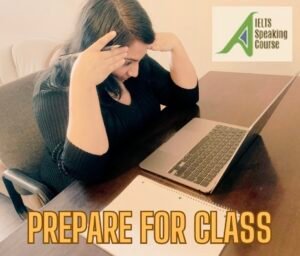Student FAQ
Click below to read questions and answers.

Contact Us
How do I contact AlyIELTS staff?

How do I contact AlyIELTS staff?
Please visit the office hours page for access to contact forms and more.
Class Preparation
How do I use this website to prepare for class?
What lessons should I do before class?
How can I organize my preparation tasks?
Why is it important for me to prepare for class?

How do I use this website to prepare for class?
Complete every lesson in the preparation module, Request Feedback and submit the Live Class Checklist. There are 5 study modules containing 39 lessons on the IELTS Speaking Course.
What lessons should I do before class?
You can find all of your lessons on the Notebook Page. Start at the beginning of the module. Complete every lesson in order.
How can I organize my preparation tasks?
You can us the 21 Day Schedule to organize your study tasks. Write down your tasks for the day and complete them every day for 21 days.
Why is it important for me to prepare for class?
Treat your live class as an opportunity to receive feedback from a knowledgeable expert. It is in your best interest then to prepare for that interaction.
Feedback
What is feedback?
Why is feedback important?
Why is it important to request feedback?

What is feedback?
Feedback is the reaction from someone given with the intention of improvement or development. When you request feedback, you give permission to that person to express themselves to the best of their ability and with honesty.
Why is feedback important?
Feedback from someone who understands where you are going and what it takes to get there is valuable. Use feedback on this course to move forward.
Why is it important to request feedback?
f you don’t request feedback, how will the person who is trying to help you actually help you in the most efficient manner?
Train
What do I study with my teacher in the live class?
What should I do when I get feedback in class?
How long is each live class?
What should I bring with me to my class?

What do I study with my teacher in the live class?
In the class, you practice with IELTS Speaking assessment tasks that you select beforehand. Your teacher will give you a chance to ask questions at the beginning of class. During the main part of the class, you run through these tasks with your teacher. Finally, your teacher will give you feedback about how you performed. You will have also studied these feedback comments before going to class.
What should I do when I get feedback?
How long is each live class?
Each class is 25 minutes in length and follows the following class format.
What should I bring with me to class?
Course Access
How do I get full course access?

How do I get full course access?
Teacher FAQ
Click below to read questions and answers.
Overview
Preparing for Class

Overview
What is PFT?
How do I use this website to teach IELTS students?
What courses are there on this website?
What should I tell students prior to making a schedule?

What is PFT?
PFT stands for Prepare Feedback Train in the context of this website. It is a learning system. It is conducive to both blended learning and to the more traditional classroom training schemes. This learning system solves one problem in the current state of blended learning by naturally integrating learner training into online pre-classroom work while providing consistency of message without uniformity in the delivery of live face-to-face training sessions. On this website, this is done by
- building up expectation in the trainee’s mind about what will happen during the event.
- providing detailed knowledge of criteria by which they will be assessed.
- making suggestions about how to practice beforehand in order to maximize success in front of the assessor.
This learning system is not new. The following situation may be recognizable.
Think about the way you learned how to teach formally. There are a million different ways a teacher trainer can help a trainee, but if you have the Cambridge English Language Teaching to Adults certificate (CELTA), you probably did something like this on the first day:
Morning: Introduction and Orientation Session (Find Someone Who playing to Eddie Rabit “I love a rainy night”).
Lunch: Stress out about all of the administrative documents.
Early Afternoon: You receive teaching practice notes and instruction from the teacher trainer about what you will do during the first teaching practice (TP) session, which is in 2 hours!
Late Afternoon: You teach your class, which may range from 3 students to 25 students depending on if it’s raining in Vancouver and if the assistant tutors have done their volunteer job of phoning all of the TP students a million times pleading with them to come to class after thinking about what the teacher trainers said to you an hour earlier.
Early Evening: You sit with your teacher trainer and receive assessment feedback both verbal and written (the blue piece of paper that you get and that belongs in the portfolio and not be taken out the center ever that says “To standard” at the top).
This is Prepare Feedback Train without a computer. The focus of the entire preparation session is directed towards the the TP. However, other skills are practiced but not emphasized on the first day because the criteria for Week 2 have not kicked in yet. Thus, a game of Tic Tac Toe as a feedback activity to a conversation activity may receive a Pass in Week 1 because the instructions are delivered clearly with graded language but not in Week 2 because the content did not lead to the clarification of the language.
Since Cambridge Teacher Trainers are among the best in the world, they use relevant knowledge and experience to sequence these criteria to become active in a step function manner over the 4 week course. This is completely up to the center, but it must be consistent within a certain standard. Otherwise the external assessor will pick a fight with one of the trainers and somebody will end up doing extra photocopy duty.
This course uses green flags as the objective assessment criteria to be delivered subjectively by the teacher to the student. The feedback comments are based on the IELTS Public Speaking Band Descriptors available on the official IELTS website. There are two types of feedback comments on this website. First, preparation feedback comments are selected by the teacher in response to student preparation. This provides scaffolding for the student and a starting point for any teacher who is familiar with the contents of the training session module. Second, assessment feedback comments are delivered immediately following the training session. These comments are both verbal and written. The teacher may choose how and when to deliver the former, but the latter must be written down on the PFT Assessment Sheet.
During their preparation, students use a number of resources to prepare for their live classes. They are exposed to language in a way that contains enough structure to produce a familiar and comfortable framework in their minds with a constant reminder of why they are doing these lessons, which is to prepare for class. This message is consolidated at the end of every lesson when the student is directed to consider the assessment comments and how the contents of the lesson will help them achieve the green flag comment as a goal for a particular task during the training session.
How do I use this website to teach IELTS students?
2. Help this student register for free.
3. Give them an orientation to the website.
4. Read the teacher notes and prepare for class in whatever way you do.
5. Provide your student with feedback to their preparation before they come to class (how?).
6. Teach your live class. Use the 25 minute class format.
What courses are there on this website?
Currently, there is an IELTS Speaking short course available for free to students and teachers (11 lessons). The IELTS Short Course consists of
- student and teacher access to 11 online student lessons
- access to teacher notes and training session materials
What should I tell students before making a teaching schedule with them?
Class Preparation
What does effective preparation involve?
What is feedback?
What are the categories of feedback on this website?
What type of feedback do I give to students in class?
What materials do I use with students use in the live class?
What do students do during the online preparation?
Where do I find my teacher notes?
What do the contents of the teacher notes entail?

What does effective preparation involve?
- building up expectation in the trainee’s mind about what will happen during the event.
- providing detailed knowledge of criteria by which they will be assessed.
- making suggestions about how to practice beforehand in order to maximize success in front of the assessor.
What is feedback?
There are actually two kinds of feedback. The feedback that one gives and the feedback that one receives. Technically speaking, when one gives feedback, they are reacting to another either verbally or through writing with the purpose of helping the receiver improve or develop in that area. On the other hand, the receiver may perceive body language and facial reactions unintended by the giver as feedback. Or criticism and/or disapproval depending on what is going on in the mind of the receiver at that particular moment in time.
In order for the teacher to deliver effective feedback, I feel that three conditions must be met:
1. There is rapport between the teacher and the student (i.e. the student feels comfortable learning with the teacher).
2. Shared experience has been understood between the teacher and the student (i.e. both student and teacher know and have respect for the rules).
3. The teacher has earned platform from the student (i.e the student trusts the teacher and believes the teacher is willing and able and capable of deciding what the best way to help them is).
What are the categories of feedback on this website?
What type of feedback do I give to students in class?
What materials do I use with students use in the live class?
What do students do during their online preparation?
The breakdown of a lesson is as follows:
Interview/Input Engagement Video: Students watch a video and answer a question.
Explanation Video: Students watch a video and read some examples accompanied by a brief explanation comment.
This continues 2 more times.
Rep: Students engage with a receptive activity consistent with the lesson theme/topic/language focus designed to draw attention to form, meaning and/or pronunciation.
Checkpoint: Students engage with a productive activity consistent with the lesson theme/topic/language focus. Teachers can look at this to form a starting platform for an activity in the live class.
Assessment: Students select an assessment task that they would like to practice with the intention of receiving feedback during the training session.
Students complete every lesson in the module, request feedback and fill out the live class checklist before coming to class. This information is stored on the AlyIELTS website.
Where do I find my teacher notes?
What do the contents of the teacher notes entail?
The teacher notes are meant as a hint for how you can better prepare for your live class. They contain all of the content in the student section of the lesson minus the videos, notes under the answer boxes to help make language patterns and features more noticeable and in some cases more salient to students, audio message at the end of the lesson and capability to submit and post answers to the feedback page.
I have arranged the extra comments in sequential order. These are not meant to be an exhaustive presentation of teaching methodology or language clarification techniques. They are intended rather to provide a running commentary on aspects of teaching and learning within the context of Prepare Feedback Train and the 25 min live class format in order to help you better prepare for your classes.


